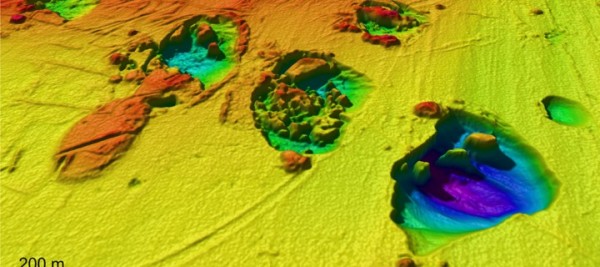By Ana Verayo, | March 16, 2016

Craters from methane bubble explosions in the Barents sea.
What is the secret behind the infamous Bermuda Triangle? Scientists reveal that methane bubble explosions apparently left massive craters on the seabed of Norway's coast that are now investigating by scientists, revealing that these pockmarked underwater regions are remnants of these methane explosions.
Like Us on Facebook
The explosions left large chasms on the ocean floor that are measured half a mile wide that is 150 feet deep. Scientists believe that these are caused by gas leaking from oil deposits that are buried deep into the seafloor. These gases are believed to accumulate into sediments on the seafloor before they bursted across the seabed, spanning the surrounding waters.
With this new finding, scientists will now be able to determine the safety hazards of these methane bubbles to passing ships, which can lead to unraveling the age old mystery why ships and other vessels disappear into the Bermuda Triangle.
In order to investigate this phenomenon, scientists developed a new radar that can reveal detailed images of the seabed. With these graphics, it can immediately identify the areas where this methane gas are expelled all over the world's oceans. This can be crucial in providing scientific explanation for reports that are needed by sailors, when waters begin to form dangerous, massive bubbles for unknown reasons.
According to the team of researchers from the Arctic University of Norway, these multiple giant craters that exist on the sea floor located in the western central Barents sea are probably the cause of huge gas blowouts. The team also suggests that this crater region is most likely home to the largest hotspots of marine methane release in the Arctic region.
Scientists also say that the bedrock under the Bermuda Triangle is full of magnetic anomalies that can generate inaccurate compass readings and directions. Apart from this, frozen methane gas deposits can explode in powerful and sudden outbursts or methane blowouts, that are capable of sinking large vessels.
The area is also prone to waterspouts which are vortices that can suck water from the sea and up into the clouds, similar to a tornado on land. Winds from these waterspouts can reach more than 190 kilometers per hour, which is prevalent during the summer due to humid air and warm waters from Florida, resulting in 400 to 500 waterspouts every year.
This notorious region in the western area of the North Atlantic ocean is also known as the "Devil's Triangle" which lies near Bermuda, Puerto Rico bordering Melbourne, Florida. For ages, numerous ships and vessels including aircraft have mysteriously disappeared since records keeping began in 1851. To date, some 8,127 people are reported lost in the Bermuda Triangle.
-
Use of Coronavirus Pandemic Drones Raises Privacy Concerns: Drones Spread Fear, Local Officials Say

-
Coronavirus Hampers The Delivery Of Lockheed Martin F-35 Stealth Fighters For 2020

-
Instagram Speeds Up Plans to Add Account Memorialization Feature Due to COVID-19 Deaths

-
NASA: Perseverance Plans to Bring 'Mars Rock' to Earth in 2031

-
600 Dead And 3,000 In The Hospital as Iranians Believed Drinking High-Concentrations of Alcohol Can Cure The Coronavirus

-
600 Dead And 3,000 In The Hospital as Iranians Believed Drinking High-Concentrations of Alcohol Can Cure The Coronavirus

-
COVID-19: Doctors, Nurses Use Virtual Reality to Learn New Skills in Treating Coronavirus Patients







